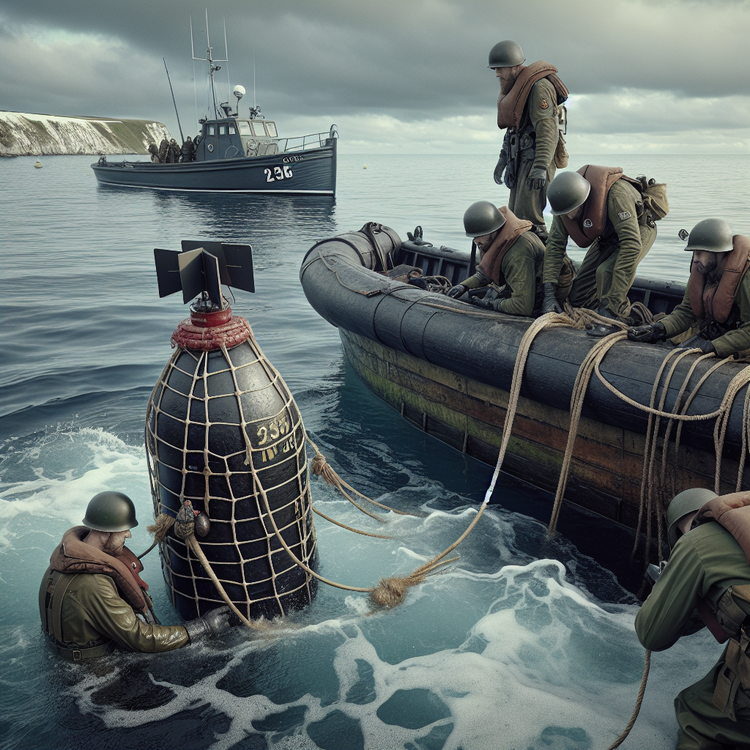A World War Two bomb was recently detonated off the coast of Denmark. The bomb, weighing 130kg, was discovered by a fisherman who immediately reported it to the authorities. In order to safely detonate the bomb, sappers from the Danish navy placed it back in the water and attached a 10kg explosive charge to it. The controlled explosion took place 15 meters below the surface, according to the defense department.
The bomb was found near Langeland, a Danish island located in the southern part of the country. It had become entangled in the fisherman’s net, prompting him to seek help. The Danish navy responded swiftly to the situation and took the necessary steps to ensure the safe detonation of the bomb.
The controlled explosion was carried out to minimize any potential risks or damage. By placing the bomb back in the water and attaching an explosive charge, the navy was able to control the explosion and ensure that it occurred at a safe depth. This approach allowed for the bomb to be safely disposed of without causing harm to anyone or any property.
This incident serves as a reminder of the lasting impact of World War Two and the presence of unexploded ordnance in certain areas. It also highlights the importance of prompt reporting and cooperation between civilians and authorities in dealing with such situations. The Danish navy’s quick response and expertise in handling the bomb ensured a safe outcome for everyone involved.
Original news source: World War Two bomb detonated off coast of Denmark (BBC)
Listen:
Slow
Normal
Fast
Vocabulary:
| 1 | detonated | Set off or cause to explode |
| 2 | fisherman | A person who catches fish for a living |
| 3 | authorities | People in positions of power or control |
| 4 | sappers | Military engineers who specialize in defusing explosives |
| 5 | explosive | Capable of causing an explosion |
| 6 | controlled | Regulated or restrained |
| 7 | entangled | Caught or trapped in a tangle or snare |
| 8 | prompt | Quick or immediate in action or response |
| 9 | minimize | Reduce or keep to a minimum |
| 10 | potential | Possible or likely but not yet realized |
| 11 | harm | Physical or mental injury or damage |
| 12 | incident | An event or occurrence |
| 13 | impact | The effect or influence of one thing on another |
| 14 | unexploded | Not detonated or exploded |
| 15 | outcome | The final result or consequence of a situation or event |
Group or Classroom Activities
Warm-up Activities:
– News Summary
Instructions:
1. Divide the class into pairs.
2. Give each pair a copy of the article.
3. Instruct the pairs to read the article and summarize it in 3-4 sentences.
4. After a designated time, have pairs share their summaries with the class.
5. Encourage discussion and compare the different summaries.
– Vocabulary Pictionary
Instructions:
1. Write a list of vocabulary words from the article on the board.
2. Divide the class into teams.
3. Give each team a whiteboard or a piece of paper.
4. Instruct each team to choose a word from the list and draw a picture representing that word.
5. The other teams must guess the word based on the drawing.
6. Each team takes turns drawing and guessing until all the words have been used.
– Pros and Cons
Instructions:
1. Divide the class into two groups.
2. Assign one group to represent the pros of detonating the bomb and the other group to represent the cons.
3. Give the groups time to discuss and come up with arguments to support their assigned position.
4. Have each group present their arguments to the class.
5. Encourage discussion and debate among the students.
– Future Predictions
Instructions:
1. Instruct each student to individually write down three predictions about the impact of the detonated bomb.
2. After a designated time, have students share their predictions with a partner.
3. Encourage discussion and ask students to explain their reasoning behind each prediction.
4. Have a few students share their predictions with the class and facilitate a class discussion about the potential outcomes.
Comprehension Questions:
1. How much did the bomb weigh?
2. Who discovered the bomb?
3. What did the fisherman do when he found the bomb?
4. How did the Danish navy ensure the safe detonation of the bomb?
5. Where was the bomb found?
6. Why did the navy place the bomb back in the water before detonating it?
7. What was the purpose of the controlled explosion?
8. What does this incident remind us of?
Go to answers ⇩
Listen and Fill in the Gaps:
A World War Two bomb was recently (1)______d off the coast of (2)______. The bomb, weighing 130kg, was (3)______ by a fisherman who immediately reported it to the authorities. In order to safely detonate the bomb, sappers from the Danish navy placed it back in the water and attached a 10kg (4)______ charge to it. The controlled explosion took place 15 meters below the surface, (5)______ to the defense department.
The bomb was found near Langeland, a Danish island located in the (6)______ part of the (7)______. It had become entangled in the fisherman’s net, (8)______ him to seek help. The Danish navy responded swiftly to the situation and took the necessary steps to ensure the safe detonation of the bomb.
The controlled explosion was carried out to minimize any potential risks or damage. By (9)______ the bomb back in the (10)______ and (11)______ an explosive charge, the navy was able to control the explosion and ensure that it occurred at a safe depth. This approach allowed for the bomb to be safely (12)______ of without causing harm to anyone or any property.
This incident serves as a reminder of the lasting impact of World War Two and the presence of unexploded ordnance in certain (13)______. It also highlights the (14)______ of (15)______ reporting and cooperation between civilians and authorities in dealing with such situations. The Danish navy’s quick response and expertise in handling the bomb (16)______ a safe outcome for everyone involved.
Go to answers ⇩
Discussion Questions:
Students can ask a partner these questions, or discuss them as a group.
1. What is your opinion on the presence of unexploded ordnance from World War Two in certain areas?
2. How would you feel if you discovered a bomb while fishing?
3. Do you think the fisherman did the right thing by immediately reporting the bomb to the authorities? Why or why not?
4. Have you ever encountered a dangerous situation like this? If so, how did you handle it?
5. What measures do you think should be taken to prevent accidents or harm caused by unexploded ordnance?
6. Do you think the Danish navy’s response to this situation was effective? Why or why not?
7. How do you think the presence of unexploded ordnance affects the local communities and their daily lives?
8. Have you ever been involved in a situation where prompt reporting and cooperation between civilians and authorities was necessary? If so, what was it like?
9. What do you think are the challenges faced by authorities in dealing with unexploded ordnance?
10. How do you think the controlled explosion was carried out to minimize risks and damage?
11. Do you think it is important for governments to allocate resources to deal with unexploded ordnance? Why or why not?
12. How do you think the presence of unexploded ordnance affects tourism and economic development in certain areas?
13. What precautions do you think fishermen and other people who work in the sea should take to avoid encountering dangerous objects like bombs?
14. Do you think the lasting impact of World War Two and the presence of unexploded ordnance should be more widely discussed? Why or why not?
15. How do you think the experience of finding and safely detonating a bomb would affect the fisherman and the navy personnel involved?
Individual Activities
Vocabulary Meanings:
Match each word to its meaning.
Words:
1. detonated
2. fisherman
3. authorities
4. sappers
5. explosive
6. controlled
7. entangled
8. prompt
9. minimize
10. potential
11. harm
12. incident
13. impact
14. unexploded
15. outcome
Meanings:
(A) Physical or mental injury or damage
(B) The effect or influence of one thing on another
(C) Military engineers who specialize in defusing explosives
(D) Not detonated or exploded
(E) Caught or trapped in a tangle or snare
(F) Quick or immediate in action or response
(G) Reduce or keep to a minimum
(H) People in positions of power or control
(I) The final result or consequence of a situation or event
(J) A person who catches fish for a living
(K) Set off or cause to explode
(L) Capable of causing an explosion
(M) Regulated or restrained
(N) An event or occurrence
(O) Possible or likely but not yet realized
Go to answers ⇩
Multiple Choice Questions:
1. How was the World War Two bomb discovered?
(a) By the Danish navy
(b) By a scuba diver
(c) By a fisherman
(d) By a tourist
2. Where was the bomb found?
(a) Near Copenhagen
(b) Near Aarhus
(c) Near Odense
(d) Near Langeland
3. How much did the bomb weigh?
(a) 130kg
(b) 100kg
(c) 150kg
(d) 200kg
4. What did the Danish navy do to safely detonate the bomb?
(a) Buried it on land
(b) Threw it into a volcano
(c) Placed it back in the water and attached an explosive charge
(d) Sent it into space
5. How deep was the controlled explosion carried out?
(a) 10 meters below the surface
(b) 15 meters below the surface
(c) 20 meters below the surface
(d) 5 meters below the surface
6. What was the purpose of the controlled explosion?
(a) To test the bomb’s power
(b) To create a spectacle for tourists
(c) To study the effects of underwater explosions
(d) To minimize potential risks or damage
7. What does this incident remind us of?
(a) The importance of prompt reporting and cooperation
(b) The lasting impact of World War Two
(c) The presence of unexploded ordnance in certain areas
(d) All of the above
8. What did the Danish navy’s quick response and expertise ensure?
(a) A safe outcome for everyone involved
(b) The bomb’s safe transportation to a museum
(c) The bomb’s safe disposal in a landfill
(d) The bomb’s safe detonation in a controlled area
True or False Questions:
1. Civilians were responsible for safely detonating the bomb, not sappers from the Danish navy.
2. The Danish navy’s slow response and lack of expertise ensured a dangerous outcome for everyone involved.
3. The bomb weighed less than 130kg and was not found by a fisherman.
4. A World War Two bomb was recently discovered off the coast of Denmark.
5. The bomb was placed back in the water and a 10kg explosive charge was attached to it for controlled explosion.
6. The controlled explosion took place 15 meters below the surface.
7. The bomb was not found near Langeland, a Danish island in the southern part of the country.
8. The fisherman promptly reported the bomb to the authorities.
Go to answers ⇩
Write a Summary:
Write a summary of this news article in two sentences.
Writing Questions:
Answer the following questions. Write as much as you can for each answer.
1. How was the World War Two bomb discovered off the coast of Denmark?
2. What steps did the Danish navy take to safely detonate the bomb?
3. Why was it necessary to place the bomb back in the water before detonating it?
4. What risks or damage could have occurred if the bomb had not been safely detonated?
5. What does this incident remind us about the lasting impact of World War Two?
Answers
Comprehension Question Answers:
1. How much did the bomb weigh?
– The bomb weighed 130kg.
2. Who discovered the bomb?
– The bomb was discovered by a fisherman.
3. What did the fisherman do when he found the bomb?
– The fisherman immediately reported the bomb to the authorities.
4. How did the Danish navy ensure the safe detonation of the bomb?
– The Danish navy placed the bomb back in the water and attached a 10kg explosive charge to it to ensure a controlled explosion at a safe depth.
5. Where was the bomb found?
– The bomb was found near Langeland, a Danish island located in the southern part of the country.
6. Why did the navy place the bomb back in the water before detonating it?
– The navy placed the bomb back in the water to control the explosion and ensure it occurred at a safe depth.
7. What was the purpose of the controlled explosion?
– The purpose of the controlled explosion was to safely dispose of the bomb without causing harm to anyone or any property.
8. What does this incident remind us of?
– This incident reminds us of the lasting impact of World War Two and the presence of unexploded ordnance in certain areas. It also highlights the importance of prompt reporting and cooperation between civilians and authorities in dealing with such situations.
Go back to questions ⇧
Listen and Fill in the Gaps Answers:
(1) detonate
(2) Denmark
(3) discovered
(4) explosive
(5) according
(6) southern
(7) country
(8) prompting
(9) placing
(10) water
(11) attaching
(12) disposed
(13) areas
(14) importance
(15) prompt
(16) ensured
Go back to questions ⇧
Vocabulary Meanings Answers:
1. detonated
Answer: (K) Set off or cause to explode
2. fisherman
Answer: (J) A person who catches fish for a living
3. authorities
Answer: (H) People in positions of power or control
4. sappers
Answer: (C) Military engineers who specialize in defusing explosives
5. explosive
Answer: (L) Capable of causing an explosion
6. controlled
Answer: (M) Regulated or restrained
7. entangled
Answer: (E) Caught or trapped in a tangle or snare
8. prompt
Answer: (F) Quick or immediate in action or response
9. minimize
Answer: (G) Reduce or keep to a minimum
10. potential
Answer: (O) Possible or likely but not yet realized
11. harm
Answer: (A) Physical or mental injury or damage
12. incident
Answer: (N) An event or occurrence
13. impact
Answer: (B) The effect or influence of one thing on another
14. unexploded
Answer: (D) Not detonated or exploded
15. outcome
Answer: (I) The final result or consequence of a situation or event
Go back to questions ⇧
Multiple Choice Answers:
1. How was the World War Two bomb discovered?
Answer: (c) By a fisherman
2. Where was the bomb found?
Answer: (d) Near Langeland
3. How much did the bomb weigh?
Answer: (a) 130kg
4. What did the Danish navy do to safely detonate the bomb?
Answer: (c) Placed it back in the water and attached an explosive charge
5. How deep was the controlled explosion carried out?
Answer: (b) 15 meters below the surface
6. What was the purpose of the controlled explosion?
Answer: (d) To minimize potential risks or damage
7. What does this incident remind us of?
Answer: (b) The lasting impact of World War Two
8. What did the Danish navy’s quick response and expertise ensure?
Answer: (a) A safe outcome for everyone involved
Go back to questions ⇧
True or False Answers:
1. Civilians were responsible for safely detonating the bomb, not sappers from the Danish navy. (Answer: False)
2. The Danish navy’s slow response and lack of expertise ensured a dangerous outcome for everyone involved. (Answer: False)
3. The bomb weighed less than 130kg and was not found by a fisherman. (Answer: False)
4. A World War Two bomb was recently discovered off the coast of Denmark. (Answer: True)
5. The bomb was placed back in the water and a 10kg explosive charge was attached to it for controlled explosion. (Answer: True)
6. The controlled explosion took place 15 meters below the surface. (Answer: True)
7. The bomb was not found near Langeland, a Danish island in the southern part of the country. (Answer: False)
8. The fisherman promptly reported the bomb to the authorities. (Answer: True)
Go back to questions ⇧












